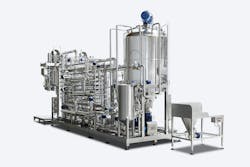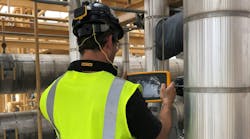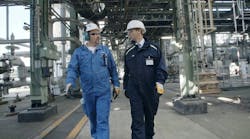Clean-in-place (CIP) systems have been around since the 1950s and in many regions and industries, they are now the standard method of maintaining hygienic and effective equipment operation. Yet we still encounter clients and manufacturers who are unfamiliar with the concept and continue to purchase or specify production equipment or systems which rely heavily on manual cleaning routines, often involving time consuming and expensive equipment breakdown.
A brief history of CIP
The production of safe food and drink products is of paramount importance to producers and maintaining hygienic (or sterile) conditions is key to this. Historically, most food production equipment was cleaned by hand, requiring the disassembly of piping, tanks and other items. Not only was this costly in terms of the time and labor required, but it also resulted in significant production downtime, and limited the design and size of processing equipment.
Some sources suggest that CIP systems were first implemented when dairies were forced to switch from metal pipes to Pyrex glass tubes during World War II, but the first automated CIP system was installed in a family-owned dairy in 1953 in the US. Non-dairy systems followed in the 1960s and the first pharmaceutical system was installed in the late-1970s. Despite this, in many industries and regions of the world, the benefits of CIP are little understood, and the use of CIP lags behind that of other territories, such as Europe.
Why choose CIP?
CIP is an automated method of cleaning food processing equipment without disassembly using validated procedures. CIP systems offer several advantages, including:
- Reducing human errors that can lead to mistakes, such as using the wrong cleaning solution concentration, or not thoroughly rinsing equipment.
- Improved health and safety by reducing or preventing employee exposure to cleaning chemicals.
- Greater operational efficiency as less production time is lost during cleaning, and employees are not required to spend long periods cleaning equipment.
- Improved product quality and consistency and less contamination of product.
- Saving water, chemicals, and energy through accurate, repeatable, and automatic actions.
A smart approach to hygiene
Prior to cleaning, as much product as possible needs to be removed from the equipment. This is often done by physical removal or using air or water under pressure. Some systems, such as the HRS R Series of scraped surface heat exchangers, can even be run in reverse to remove and recover as much product as possible. Some of the most common elements of a CIP system include pre-rinsing, a high temperate caustic or chemical wash, and various intermediate and final rinses. Washing processes use a combination of chemicals and agitation (such as turbulent flow in corrugated pipes) to remove dirt.
All these processes are controlled by integrated controls and systems such as flow meters, conductivity transmitters and turbidity sensors. Depending on the system, the final rinse may use potable or sterilized water, or another form of sanitizing rinse containing bleach or peracetic acid (PAA), although in many situations it is preferable to rely on water alone. Air may also be passed through the system to ensure it is fully dry before production recommences.
CIP systems are generally classified as either single use or reuse. Single use systems discard all the liquid after use, while reuse systems store cleaning fluids for reuse in subsequent cleaning cycles. CIP systems can be integrated into the original manufacturing equipment or can be based on standalone systems that operate on and control one of more pieces of equipment. Modern CIP systems will assist with record keeping for the purposes of traceability, including recording of key parameters such as temperature, pressure, chemical concentration and cleaning time.
Design considerations for CIP
If CIP is to be effective, not only does the CIP system itself need to be well designed, but the production equipment should also be considered with effective CIP in mind from the outset. Equipment and machinery must be hygienically designed and easy to manage, maintain and audit.
The design process must not only ensure effective cleaning but should also be as efficient as possible in terms of water, chemical and energy use. Considerations for the equipment itself include areas such as surface roughness, clean welding and the prevention of inaccessible areas or corners where dirt and/or cleaning chemicals may build up. Reliability is also an important consideration and CIP systems must be designed to operate for as long as the working lifetime of the equipment involved. It is also important to consider how user-friendly the control systems for CIP are. For example, are they part of the overall control interface or a separate system?
CIP systems from HRS
HRS offers both integrated and standalone CIP systems. Integrated CIP is included in many of our complete systems, such as HRS pasteurizers and sterilizers, as well as our Asepticblock Series (where the AF aseptic filler & pasteurizer/sterilizer are combined in one skid) and stand-alone aseptic fillers, for example.
Our standalone CIP systems are fully skid mounted and have modular designs for quick and easy site installation. The single-tank (ST) system is designed for simple cleaning applications where recovery of the cleaning fluid is not required, while multi-tank (MT) systems are suitable for more complex situations.
For small, portable applications, the tank can be heated to 185°F using electric heating elements, but steam heating using an HRS K Series multitube heat exchanger is also available. Units start at 110-gallon capacity, and single tank systems are available up to 550 gallons. Larger systems can be provided using multiple tanks, and centrifugal sanitary pumps are fitted as standard. Systems are fully automated using Programmable Logic Controller (PLC) systems and Human-Machine Interfaces (HMI), which can be standalone or integrated into the factory’s main control system.
Matt Hale is an International Sales & Marketing Director for HRS Heat Exchangers.


